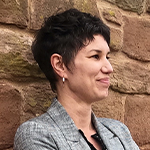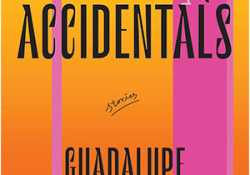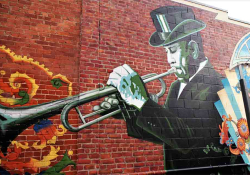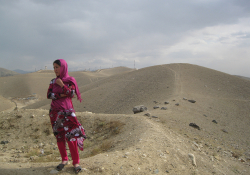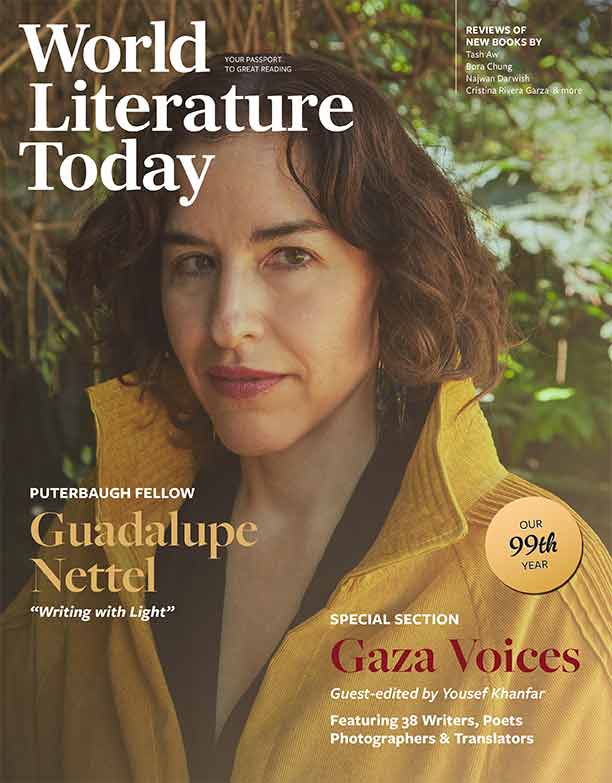Writing with Light: The 2025 Puterbaugh Lecture

Nettel delivered the following keynote talk, “Escribir con luz,” in Spanish, alternating with the English read by her translator, Rosalind Harvey.
“I was born with a white beauty mark, or what others call a birthmark, covering the cornea of my right eye. That spot would have been nothing had it not stretched across my iris and over the pupil through which light must pass to reach the back of the brain. They didn’t perform corneal transplants on newborns in those days; the spot was doomed to remain for several years. And in the same way an unventilated tunnel slowly fills with mold, the pupillary blockage led to the growth of a cataract. The only advice the doctors could give my parents was to wait: by the time their daughter finished growing, medicine would surely have advanced enough to offer the solution they now lacked.
In the meantime, they advised subjecting me to a series of annoying exercises to develop, as much as possible, the defective eye. This was done with ocular movements . . . but also—and this I remember most—with a patch that covered my left eye for half the day. It was a piece of flesh-colored cloth . . . covering my upper eyelid down to the top of my cheekbone. . . . Wearing the patch felt unfair and oppressive. It was hard to let them put it on me every morning and to accept that no hiding place and no amount of crying could save me from that torture . . . With the patch, I had to go to school, identify my teacher and the shapes of my school supplies, come home, eat, and play for part of the afternoon.
At around five o’clock, someone would come to say it was time to take it off, and with these words I would return to the world of clarity and precise shapes. The people and things around me suddenly changed. I could see far into the distance and would become mesmerized by the treetops and infinite leaves that composed them, the contours of the clouds in the sky, the tint of the flowers, the intricate pattern of my fingertips. My life was divided between two worlds: that of morning, built mostly out of sounds and smells, but also of hazy colors; and that of evening, always freeing, yet at the same time, overwhelmingly precise.”
This is the opening to The Body Where I Was Born, the novel that tells of my childhood, a childhood defined by certain profound events: in the personal realm, my struggle to see with both eyes, and in the political, the exile of so many Latin American peoples who were fleeing the dictatorships of the 1970s.
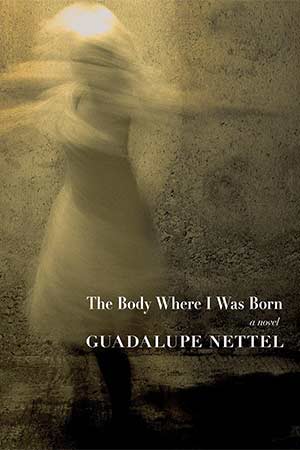 Moving back and forth between these two worlds, that of light and that of shadows, taught me to marvel, as I relate in the book, at the most quotidian objects and occurrences, to seek out different, unsuspected angles to them, to know that silhouettes and shapes are just as important as details, to never, ever trust first impressions, nor to take anything for granted. Every writer has a particular way of seeing the world, and in mine, these chiaroscuros, this play of light and shadow, hold a very important place. Since I have never been able to take much in with my sight, I must take great care when deciding which things I wish to focus my gaze on.
Moving back and forth between these two worlds, that of light and that of shadows, taught me to marvel, as I relate in the book, at the most quotidian objects and occurrences, to seek out different, unsuspected angles to them, to know that silhouettes and shapes are just as important as details, to never, ever trust first impressions, nor to take anything for granted. Every writer has a particular way of seeing the world, and in mine, these chiaroscuros, this play of light and shadow, hold a very important place. Since I have never been able to take much in with my sight, I must take great care when deciding which things I wish to focus my gaze on.
Wearing a patch over my left eye and being practically blind in the right one turned me, psychologically at least, into a child who, if not openly marginalized, was at least different. The attitude of my classmates as well as my parents’ constant battle to try and put me back together made me feel, from a very early age, that I had come into the world with something broken, something defective, something it was necessary to fix at all costs. The Body Where I Was Born speaks of the superhuman effort my parents made to integrate me into what they considered the group of “normal people.” In fact, from my first novel, El huésped, right through to the most recent, Still Born, I have tried to question the ideas people tend to have about what is “normal” and what is “abnormal”—concepts I do not believe in—and to invite my readers to do the same.
“No one is normal close-up,” as the Brazilian saying goes, and this is why in almost all my books I have tried, on one hand, to enact a kind of close-up of these supposed abnormalities, which to me seem beautiful, and, on the other, to turn a spotlight on those subjects that people tend to keep in the shadows, if not in utter darkness—the uncomfortable subjects, those that many people feel it is better not even to glance at.
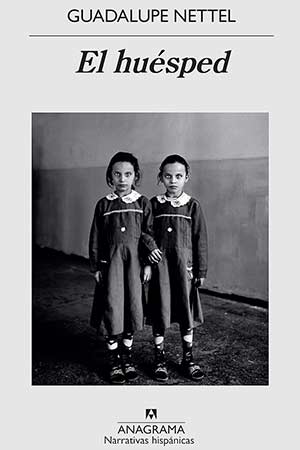 For instance, when I began my career at the start of this century, the prevailing idea of beauty was far more uniform and conventional than it is today. The bodies that we now call nonconformist were considered obscene, and the concept of body positivity did not exist yet. Back then, it was rare to talk about this, and still less common to celebrate unconventional beauty as I did in El huésped or Bezoar, whose characters are individuals with peculiarities, whether they be physical or psychological, that at times lead them to be marginalized. For me, these characters were not only interesting but also beautiful in their uniqueness. Still Born, my most recent novel, also explores the subject of divergent bodies, in particular the body of Inés, affected by a severe neurological disability, and her parents’ wish to discover who their daughter really is, beyond any medical diagnosis or the ideas that others have about her. It also explores the experience of women who chose not to be mothers—a group that, in my view, are still underrepresented in literature—and the prejudices that hang over them.
For instance, when I began my career at the start of this century, the prevailing idea of beauty was far more uniform and conventional than it is today. The bodies that we now call nonconformist were considered obscene, and the concept of body positivity did not exist yet. Back then, it was rare to talk about this, and still less common to celebrate unconventional beauty as I did in El huésped or Bezoar, whose characters are individuals with peculiarities, whether they be physical or psychological, that at times lead them to be marginalized. For me, these characters were not only interesting but also beautiful in their uniqueness. Still Born, my most recent novel, also explores the subject of divergent bodies, in particular the body of Inés, affected by a severe neurological disability, and her parents’ wish to discover who their daughter really is, beyond any medical diagnosis or the ideas that others have about her. It also explores the experience of women who chose not to be mothers—a group that, in my view, are still underrepresented in literature—and the prejudices that hang over them.
El huésped has, as an epigraph, some lines by Jean Paulhan that could perfectly well describe any one of my books:
Know that it is about saving oneself whole with one’s deficiencies, with one’s calluses, with all the inconsistencies, contradictions, and absurdities that a man may have. All this is what we must bring out into the light: the madman that we are.
In this first novel, which has not yet been translated into English, blindness is one of the central themes. Ana, the young female protagonist, knows from an early age that when she grows up she will go blind. The story takes place in Mexico City and is a kind of ode to the city and its residents, especially those who live in poverty, who camp out next to ATMs, in the stations of the metro or under bridges, and who are constantly apprehending us yet without our ever stopping to talk to them, all these “invisible” people over whom many of us cast another type of shadow: indifference and disdain. El huésped, Bezoar, After the Winter, and Still Born emerge from this endeavor to look at what hurts us, at what makes us uncomfortable.
Let’s return to my childhood. The decade I was born in, the 1970s, was also an interesting one from a historical perspective. Latin America was being ravaged by military dictatorships such as those of Augusto Pinochet in Chile, Jorge Videla in Argentina, and Juan María Bordaberry in Uruguay, fascist regimes that repressed dissidents with torture and clandestine assassinations. Most artists and intellectuals were opposed to these governments, and many were forced into exile to save their lives. Mexico opened its doors to all these refugee families, and I had the good fortune to be born in and spend my childhood in the neighborhood where they all ended up living. I grew up hearing different accents in Spanish. I found out, for instance, that calabacitas, or courgettes, can also be called zapallitos or calabacines, zucchini or little squash; I learned customs that were not precisely my own, such as drinking maté or a glass of milk at four in the afternoon. Living among migrants led me to develop a sense of curiosity toward different cultures, something that has stayed with me, as has as a deep respect for people who are forced to leave their countries and start from zero.
Human beings, like many other animal species, are migratory. According to historians, Homo sapiens has spent more time being nomadic than sedentary. Movement and the ability to adapt to a highly diverse range of environments are ingrained in our DNA. In recent years, however, migration has been seen solely as a problem to tackle. We have forgotten all about its complexity and the beneficial effects it can also have. In my most recent collection of short stories, The Accidentals, I use the albatross, those beautiful austral birds, to represent the South American exiles who had to cross long distances in order to survive, but also all those who, without being migrants, have been blown off course by the speed with which the world is changing, what with the global health crisis we went through in 2020 (the psychological aftereffects of which we are still seeing today), all the dizzying political events, but also the uncertainty and anxiety the climate crisis stirs up in us. I think we can all agree that we are witnessing a difficult moment for humanity. In the last few years, the world seems to have moved closer to obscurantism, authoritarian politics, nationalist prejudices, racism, and other attitudes that in the past have led to catastrophes such as the Second World War.
Although I have always thought that neither art nor literature is obliged to serve any political cause, no matter how important or urgent it might be—that is, that its only real purpose is to be art and to be literature—I also believe they are both particularly effective when it comes to describing extreme situations, such as persecution, deportation, hunger, exile, immigration, and to putting those of us who have not lived through these things personally in the position of those who have. More so than the great majority of journalistic texts, literature is a powerful vehicle for empathy. I am thinking of such books as If This Is a Man, by Primo Levi; A Bag of Marbles, by Joseph Joffo; The Phone Call, by Leila Guerriero; Hurricane Season, by Fernanda Melchor; and Small Country, by Gaël Faye, in which the experience of being uprooted, especially the anguish of being persecuted, are superbly dealt with.
Although I do not believe that literature should have a political cause, I do believe in its capacity to allow us to imagine and to see our neighbors. The capacity to imagine the other, to put ourselves in their shoes, is an incredibly powerful spell against fanaticism. Literature has the power to allow us to connect with one another, to see ourselves beyond ideologies and prejudices, to enter into a zone of intimacy, into the everyday lives of other people, other nations, and to share their stories, their fears, their hopes, and their life experiences—in other words, to shed light on the other, permitting us to truly see them.
Although I do not believe that literature should have a political cause, I do believe in its capacity to allow us to imagine and to see our neighbors.
Difference and migration, the acceptance of humans by other humans, are, in short, the subjects I have tried to tackle in my fiction. But there is another aspect of my work that I would like to share with you. For this, let’s return one last time to my childhood. When I was in primary school, that Montessori school I described in El cuerpo en que nací, some friends and I put together a news bulletin called La Hormiga (The Ant) that was pinned up on a board each week, and later a photocopied magazine called The Voice. Ever since then I have been a keen follower of literary and cultural magazines. Years later, when I was a student at university, I edited along with a different group of friends a magazine of Latin American youth literature called Semestral, and then one called Número Cero. Back then, as incredible as it might seem now, there was no internet yet, and magazines were an essential public platform for youth to be able to read about one other and keep up-to-date with what our contemporaries were doing in other countries around the world. In the pages of these magazines, the endeavors of people with different stories, different points of view, all converge. They constitute an exceptional space for dialogue that it is crucial to defend. While some went on to find institutional support, at first these magazines were published with our own money and that of our friends.
Between 2017 and 2024 I was lucky enough to edit the Revista de la universidad de México, published by the National Autonomous University of Mexico (unam). It was a thrilling project because it involved taking a historic publication and transforming it in such a way that it appealed to young people while still honoring its tradition. The magazine was published online as well as in print form and ended up having 300,000 readers around the world. We produced around eighty special interdisciplinary issues in which the sciences, literature, and the humanities all converged, covering topics as important as identity, the climate emergency, racism, water, families, extinction, decolonization, feminism, violence, and school.
I think every writer should edit at some point in their career. For someone accustomed to the silence and serenity of their study, to the rhythms their own work (often self-referential) suggests to them, editing constitutes a genuine challenge, an opportunity to escape from solipsism and take an interest in the work others are engaging in, not selfishly, as happens when we read to fortify our own creations, but with the joyous, generous attitude of someone planning a party. As I edited, I realized that both tasks had more in common than I first believed. In order to put together each issue of the magazine, it is also necessary to find a tone, a rhythm, an order, a focus. As with writing, editing forces us to go through moments of ecstasy and of despair.
Editing a cultural magazine allowed me to cover political subjects that I would never have been able to talk about on my own; it allowed me, in short, to shine a powerful spotlight on those who, because of where they come from or their social class, or simply because they lack the necessary language, cannot always find a space where they will be listened to as they deserve to be—to help their light be reflected in its pages.
In Mexico we have a saying that goes, de la vista nace el amor—something like “love begins in the eyes.” It means that in order to love something or someone, first we need to see them. This applies very well to food and to attraction between people, but also to another kind of love, which is that of compassion, in its etymological sense, “to feel with the other,” precisely what our society and our planet need most these days.
To conclude, I would like to say that I do not believe there is a great deal that we as individuals can do to change the incredibly dark direction the world has taken over the last few years, which is putting so many human lives in danger. What we can do—and what I would like to exhort you to do—is to care for our own light, just as one cares for the flame of a candle, and to keep it burning brightly, so that, when the occasion arises, we can offer it to whoever is near us and might need it, and also so that, when the time comes, we can add it to the light of so many others: the light of the collectives and communities that still believe in the possibility of a better world and are prepared to build it.
Translation from the Spanish
Editorial note: Read Harvey’s essay on translating Nettel from this same issue. Nettel’s essay will be reprinted in the WLT centennial anthology, Compass on the Navigable Sea, edited by Daniel Simon and forthcoming from Restless Books in spring 2026.

